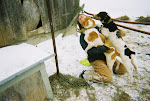 Within the past year I have become increasingly fascinated by Yurts. Perhaps part romantic ideal, part living a more simple life dream, but for some reason these round structures speak to my very being; inspire simplicity and thought, ask me to take a deep breath.
Within the past year I have become increasingly fascinated by Yurts. Perhaps part romantic ideal, part living a more simple life dream, but for some reason these round structures speak to my very being; inspire simplicity and thought, ask me to take a deep breath.Yurt (noun): a circular, portable shelter used by Central Asian nomads for over 2,000 years (yurtinfo.org)
The Yurt. What an adaptable structure. Although initially constructed over 2,000 years ago for use in the steppes of Central Asia by nomadic herders, the basics of these dwellings have been borrowed and modified to allow yurt construction in a variety of weather conditions. One of my first questions when I began getting interested was whether or not the yurt could survive an Iowan winter. Although our winters are not what they used to be (so those who have lived here, and their parents before them, say) I was worried they would be unable to withstand the buildup of snow (which, after I got to thinking, would probably melt due to the heat). I was also worried about what moisture and the freeze/thaw would do to the canvas and wooden pieces that are used in the construction. Not to worry. As I gathered more information and conducted more research (which, I must admit, is still minimal in the scheme of things) I have begun to decide that one day I WILL live in a yurt!
Benefits of Yurt Living:
- Round structure promotes a more efficient use of space
- They are very efficient to heat and there are many ways to heat them (wood, corn, LP, electric)
- Require no internal support system
- Promotes a closeness with nature traditional housing sometimes doesn't capture
- Better sleep--so I hear.
I happened to pick up a brochure for the North House Folk School, located in Grand Marais, Wisconsin, a while back, and while flipping through came upon a course entitled, "Nomadic Pursuits: Building Your Own Yurt." For more information on this, and other classes, I encourage you to explore their website--there is garaunteed to be something to spark your creative interests! I am, as of now, undecided about attending this 5-day course, but with curiosity and interest piqued, I shall continue my exploration of this indigenous housing-style and allow myself to continue to dream!
Sites to Explore!
